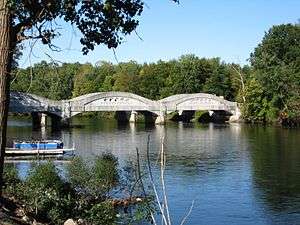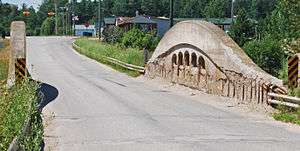Concrete curved-chord through girder bridge


A concrete curved-chord through girder bridge, sometimes known as a camelback bridge,[2][lower-roman 1] is a type of concrete bridge most common in the U.S. state of Michigan and the Canadian province of Ontario.[1] The type was designed by C.V. Dewart, the first professional bridge engineer of the Michigan State Highway Department.[3] By the early 1920s, the Michigan State Highway Department had produced standardized designs for these bridges in lengths of 50, 60, 70, 75 and 90 feet.[1] The first such bridge in Michigan was built in 1922 over the Raisin River at Tecumseh. By the end of the decade, the design fell out of favor since they could not be widened to handle increasing traffic.[4]
As of 2012, the longest surviving example in Michigan is the three-span, 270-foot-long (82 m) US 12–St. Joseph River Bridge, built in 1922 in Mottville.[1]
List of bridges
Notes
- ↑ The term 'camelback' is more commonly applied to a steel Parker truss with five segments.
References
- 1 2 3 4 Staff. "US-12 St. Joseph River Bridge". State Historic Preservation Office. Michigan State Housing Development Authority. Archived from the original on December 24, 2012. Retrieved August 30, 2012.
- ↑ "Historic Indian River bridge to be no more". Petoskey News-Review. October 25, 2011. Retrieved August 31, 2012.
- ↑ "Overview: M-32 Spur Bridge". Michigan Department of Transportation. Retrieved August 31, 2012.
- ↑ "Wadhams Rd. / Pine River". Historic Bridges. Michigan Department of Transportation. Retrieved August 31, 2012.
| Wikimedia Commons has media related to Concrete curved-chord through girder bridges. |